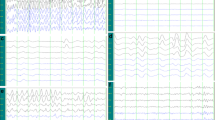Abstract
Schizophrenia is a prevalent psychiatric disease with heterogeneous causes that is diagnosed based on history and mental status examination. Applied electrophysiology is a non-invasive method to investigate the function of the involved brain areas. In a previously understudied population, we examined acute phase electroencephalography (EEG) records along with pertinent Positive and Negative Syndrome Scale (PANSS) and Mini Mental State Examination (MMSE) scores for each patient. Sixty-four hospitalized patients diagnosed to have schizophrenia in Ebn-e-Sina Hospital were included in this study. PANSS and MMSE were completed and EEG tracings for every patient were recorded. Also, EEG tracings were recorded for 64 matched individuals of the control group. Although the predominant wave pattern in both patients and controls was alpha, theta waves were almost exclusively found in eight (12.5 %) patients with schizophrenia. Pathological waves in schizophrenia patients were exclusively found in the frontal brain region, while identified pathological waves in controls were limited to the temporal region. No specific EEG finding supported laterality in schizophrenia patients. PANSS and MMSE scores were significantly correlated with specific EEG parameters (all P values <0.04). Patients with schizophrenia demonstrate specific EEG patterns and show a clear correlation between EEG parameters and PANSS and MMSE scores. These characteristics are not observed in all patients, which imply that despite an acceptable specificity, they are not applicable for the majority of schizophrenia patients. Any deduction drawn based on EEG and scoring systems is in need of larger studies incorporating more patients and using better functional imaging techniques for the brain.


Similar content being viewed by others
References
Freedman R (2003) Schizophrenia. N Engl J Med 349(18):1738–1749
Carpenter WT Jr, Buchanan RW (1994) Schizophrenia. N Engl J Med 330(10):681–690
Mortensen PB, Pedersen CB, Westergaard T, Wohlfahrt J, Ewald H, Mors O et al (1999) Effects of family history and place and season of birth on the risk of schizophrenia. N Engl J Med 340(8):603–608
Kane JM (1996) Schizophrenia. N Engl J Med 334(1):34–42
Galderisi S, Mucci A, Volpe U, Boutros N (2009) Evidence-based medicine and electrophysiology in schizophrenia. Clin EEG Neurosci 40(2):62–77
Malow BA, Reese KB, Sato S, Bogard PJ, Malhotra AK, Su TP et al (1994) Spectrum of EEG abnormalities during clozapine treatment. Electroencephalogr Clin Neurophysiol 91(3):205–211
Knott V, Labelle A, Jones B, Mahoney C (2001) Quantitative EEG in schizophrenia and in response to acute and chronic clozapine treatment. Schizophr Res 50(1–2):41–53
Nagase Y, Okubo Y, Toru M (1996) Electroencephalography in schizophrenic patients: comparison between neuroleptic-naive state and after treatment. Biol Psychiatry 40(6):452–456
Omori M, Koshino Y, Murata T, Murata I, Nishio M, Sakamoto K et al (1995) Quantitative EEG in never-treated schizophrenic patients. Biol Psychiatry 38(5):305–309
Harris AW, Bahramali H, Slewa-Younan S, Gordon E, Williams L, Li WM (2001) The topography of quantified electroencephalography in three syndromes of schizophrenia. Int J Neurosci 107(3–4):265–278
Javanbakht A, Sanati M (2006) Psychiatry and psychoanalysis in Iran. J Am Acad Psychoanal Dyn Psychiatry 34(3):405–414
Matsuura M, Yoshino M, Ohta K, Onda H, Nakajima K, Kojima T (1994) Clinical significance of diffuse delta EEG activity in chronic schizophrenia. Clin Electroencephalogr 25(3):115–121
Sponheim SR, Clementz BA, Iacono WG, Beiser M (1994) Resting EEG in first-episode and chronic schizophrenia. Psychophysiology 31(1):37–43
De Vico Fallani F, Maglione A, Babiloni F, Mattia D, Astolfi L, Vecchiato G et al (2010) Cortical network analysis in patients affected by schizophrenia. Brain Topogr 23(2):214–220
Magomedov RA, Garakh ZhV, Orekhov IuV, Zaitseva IuS, Strelets VB (2010) Gamma-rhythm, positive, negative symptoms and cognitive dysfunction in schizophrenia. Zhurnal nevrologii i psikhiatrii imeni SS Korsakova/Ministerstvo zdravookhraneniia i meditsinskoi promyshlennosti Rossiiskoi Federatsii, Vserossiiskoe obshchestvo nevrologov [i] Vserossiiskoe obshchestvo psikhiat 110(1):78–83
Widdess-Walsh P, Sweeney BJ, Galvin R, McNamara B (2005) Utilization and yield of EEG in the elderly population. J Clin Neurophysiol 22(4):253–255
Centorrino E et al (2002) EEG abnormalities during treatment with typical and atypical antipsychotics. Am J Psychiatry 159:109–115
Takahashi T, Cho RY, Mizuno T, Kikuchi M, Murata T, Takahashi K et al (2010) Antipsychotics reverse abnormal EEG complexity in drug-naive schizophrenia: a multiscale entropy analysis. Neuroimage 51(1):173–182
Bob P, Glaslova K, Susta M, Jasova D, Raboch J (2006) Traumatic dissociation, epileptic-like phenomena, and schizophrenia. Neuro Endocrinol Lett 27(3):321–326
Sachdev P, Brodaty H, Roubina S, Mackenzie RA (1999) An electroencephalographic investigation of late-onset schizophrenia. Int Psychogeriatr 11(4):421–429
Wu X, Liu XQ (1995) Study of the alpha frequency band of healthy adults in quantitative EEG. Clin Electroencephalogr 26(2):131–136
Lebedeva IS, Kaleda VG, Tsutsul’kovskaia M (2003) The relationship between clinical changes in schizophrenia, acoustic evoked potentials, and background electroencephalogram. Zhurnal nevrologii i psikhiatrii imeni SS Korsakova/Ministerstvo zdravookhraneniia i meditsinskoi promyshlennosti Rossiiskoi Federatsii, Vserossiiskoe obshchestvo nevrologov [i] Vserossiiskoe obshchestvo psikhiat 103(7):16–20
Gross A, Joutsiniemi SL, Rimon R, Appelberg B (2006) Correlation of symptom clusters of schizophrenia with absolute powers of main frequency bands in quantitative EEG. Behav Brain Funct 2:23
Gerez M, Tello A (1995) Selected quantitative EEG (QEEG) and event-related potential (ERP) variables as discriminators for positive and negative schizophrenia. Biolog Psychiatry 38(1):34–49
Higashi Y, Momotani Y, Suzuki E, Kaku T (1987) Clinical and EEG studies of zotepine, a thiepine neuroleptic, on schizophrenic patients. Pharmacopsychiatry 20(1 Spec No):8–11
Siekmeier PJ, Stufflebeam SM (2010) Patterns of spontaneous magnetoencephalographic activity in patients with schizophrenia. J Clin Neurophysiol 27(3):179–190
Conflict of interest
None.
Author information
Authors and Affiliations
Corresponding author
Rights and permissions
About this article
Cite this article
Chaychi, I., Foroughipour, M., Haghir, H. et al. Electroencephalographic characteristics of Iranian schizophrenia patients. Acta Neurol Belg 115, 665–670 (2015). https://doi.org/10.1007/s13760-014-0415-7
Received:
Accepted:
Published:
Issue Date:
DOI: https://doi.org/10.1007/s13760-014-0415-7




